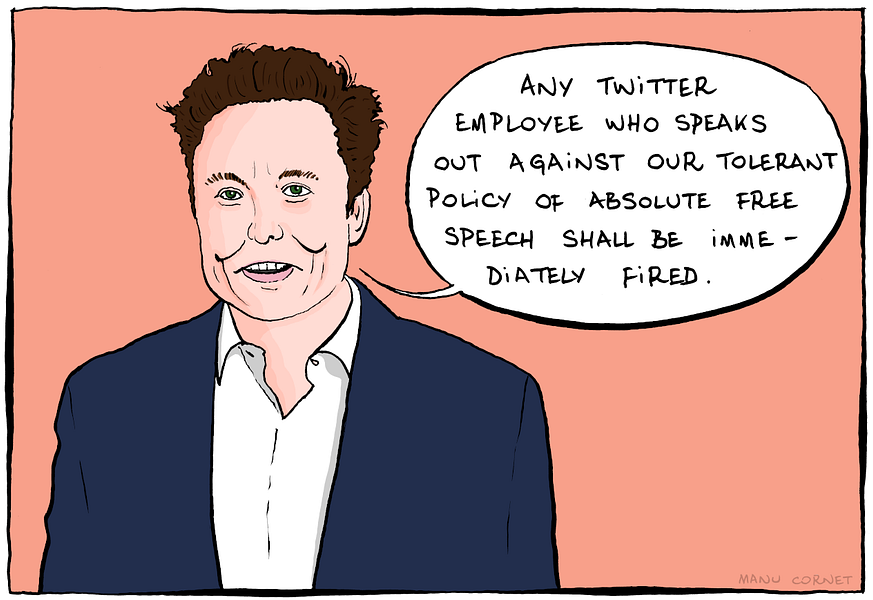The untold story of Twitter’s union drive and how Elon Musk busted it
We were helping organize a union at Twitter when Musk took over the company. Here's what we learned from witnessing his playbook up close.
This week’s post is a bit different from my usual ramblings on the political economy of innovation and technology. It’s a piece co-written with my dear friend and long-time collaborator, Clarissa Redwine, about our experience organizing a labor union at Twitter during Elon Musk’s takeover. Clarissa is a tech worker and labor organizer. She helped win the first-ever tech union at Kickstarter and produced The Kickstarter United Oral History, a beloved podcast within the tech-labor community that chronicles how Kickstarter workers successfully organized their union.
As readers of my newsletter may know, labor is central to how I think about innovation and technology (e.g., see my piece on why labor relations were a key aspect of DeepSeek's success). I hope that's reflected in this piece as well.
This past week has shown us that Elon Musk is set on gutting the government. Less than a month into the new administration, he’s seized control of the treasury's payment system, announced the shutting down of the USAID, and cut billions in medical research funding.
For us—the two authors of this post—these developments, especially Musk’s quit-or-be-fired ultimatum to federal employees, are a chilling echo of something we witnessed firsthand. The year Musk took over Twitter, we were both union staffers working with the platform's employees to organize a union. We saw up close how he gutted entire departments, surrounded himself with loyalists, and consolidated power at the company.
The comparison isn’t new. Many have already noted how Musk is running the same playbook on government agencies that he used on Twitter. What we hope to offer here is something different: an inside look at how Musk cemented his power, how workers fought back, and what those struggles can teach us now as we watch history repeat itself.
The context, the organizational structure, and the sheer scale of Musk's gutting of the government are obviously very different from the case of Twitter. Twitter, after all, was just a social media platform. Federal agencies, on the other hand, are the backbone of essential public services, responsible for everything from providing aid to veterans to supporting public health, research, and disaster response. And so we must be prudent not to draw parallels lightly. But seeing all the news about Musk and his dismantling of the government this past week, we think its critical to share our interpretation of the Musk playbook from our days of organizing at Twitter.
The acquisition
When we started as staffers for an underground union campaign at Twitter, Musk was already in the picture. He had just made his bid to buy the company, but from the inside, it felt unlikely to go through. For months, headline after headline suggested Musk was doing everything he could to back out of the deal—accusing Twitter of misrepresenting the scale of its spam problem as a way to justify walking away.
But by October, it became clear that Musk wouldn’t be able to back out. That’s when a new rumor began to circulate: the Washington Post reported that Musk was planning to lay off 75% of Twitter’s workforce, reducing headcount from over 7000 to just 2000 employees—a brutal cost-cutting measure for a company he was now being forced to buy.
While Musk claimed that the company was bloated and that layoffs were necessary for Twitter’s financial viability, the political context surrounding his bid told a different story. It was clear to us that the real goal behind the layoffs was ideological: to eliminate the left-leaning employees who, in his view, had policed free speech (e.g., by pushing Twitter to ban Trump's Twitter account after inciting the January 6th riots).
Shortly after the layoff rumors broke, Bloomberg reported a contradictory story—that no such mass layoffs were being considered. Looking back at this, it seemed like Musk recanting his statement about layoffs was nothing more than a smokescreen to lower the risk of employee sabotage.
Nevertheless, these rumors about Musk's intended layoffs sparked a new wave of energy among workers who had been trying for months to mobilize their colleagues in support of a union. Within a week of the layoff rumors spreading, Twitter employees—the very ones we had been organizing with—began circulating an open letter within the company. The letter called on Musk to preserve Twitter’s headcount after the acquisition, demanded that his new management team refrain from discriminating against employees based on political beliefs, and urged a commitment to fair severance policies and greater transparency around working conditions.
(You can find a leaked version of the letter published in– Time Magazine)
In the short term—literally the week before Musk’s arrival—the letter ignited a surge of organizing energy. Our organizing committee—the core group leading the union effort—was calling coworkers, engaging in heated discussions, and rallying employees around the urgent need to unite and push back against the incoming management. Meanwhile, the two of us were swept up in the momentum as well, running back-to-back organizing trainings to equip newcomers with the skills to bring others on board. Most of all, we were getting buy-in that what was urgently needed, above all, was a union.
Unfortunately, there just wasn’t enough time.
On October 22, 2022, Musk arrived at Twitter's HQ as the company's new owner, sink in hand (he tweeted a video of himself holding the sink with the caption "Entering Twitter HQ--let that sink in"). Within a week of his new management, layoffs commenced, and Twitter would be forever changed.
Layoffs and new management practices
Whether or not Musk ever read the letter remains unclear to us. If he did, he seemed determined to do the exact opposite of what Twitter employees had demanded—preserving headcount and refraining from discrimination.
The first round of layoffs hit within Musk’s first week. Right out of the gate, the company’s Ethical AI team—responsible for making Twitter’s algorithms more transparent and fair—was axed. Since Musk opposed content moderation, the teams dedicated to that work were fired as well. The entire C-suite, including CEO Parag Agrawal, was replaced with Musk loyalists. According to The New York Times, roughly 50% of the company was laid off, slashing Twitter’s workforce from over 7,000 employees to around 3,700.
At this point, the layoffs were only just getting started. In this initial round, Musk targeted what were, from his perspective, the obvious groups. The Ethical AI team was likely seen as a stronghold of left-leaning liberals—exactly the kind of people he believed were “ruining” the company. The same went for content moderation teams, whom he blamed for censoring the kind of bigoted politics he often aligned with—and was almost certainly guilty of promoting himself.
Another easy target was the critics. Anyone who publicly or even internally questioned his decisions quickly found themselves on the chopping block. Notably, Manu Cornet—well-known for his sharp, satirical comics about the tech industry—was among those fired, presumably for creating a simple tool to help employees back up their work emails in case they lost their jobs. Eric Frohnhoefer, a highly respected staff engineer at Twitter, was also laid off for publicly disagreeing with Musk. After Musk tweeted about the platform’s slowness, Frohnhoefer responded directly, pointing out that Musk was mistaken about the cause. What followed was a brief back-and-forth on Twitter, after which Musk abruptly announced—on Twitter itself—that Frohnhoefer was fired (this was also how Frohnhoefer found out).1
Beyond these initial targets, however, deciding how to further shrink the workforce without completely breaking the platform required a bit more care. To handle this, Musk brought in loyal Tesla employees to continue the downsizing spree. Working under tight deadlines and with little to no understanding of Twitter’s codebase, these Tesla engineers resorted to the quantity of code—literally the number of lines written—produced by each engineer, a measure most programmers would agree is not only meaningless but actively misleading when it comes to assessing the quality of an engineer (a good engineer would, in theory, use fewer lines to achieve the same results).2
On top of that, the remaining engineers were instructed to select their “most salient” code contributions, print them out on paper, and bring them to an “interview” with a Tesla engineer who would ultimately decide their fate at the company.
(More details on this process in this interview with Manu Cornet)
Unsurprisingly, this approach proved to be a completely ineffective way to identify strong engineers or ensure that Twitter’s core functionality remained intact. By the third week of Musk’s takeover, the company was already scrambling to rehire some of the very employees it had hastily laid off, a clear sign of the chaos and short-sightedness driving Musk's process.
By this point, the vast majority of our organizing committee had already been cut from the company—partly by coincidence, but also because many had worked in precisely the teams Musk targeted first. Perhaps unsurprisingly, for a union drive, our committee was made up of people deeply invested in AI ethics and committed to safeguarding public discourse from right-wing, bigoted content. Still, the organizing didn’t stop. Amid the chaos, the committee kept going, with even those who had been laid off continuing to join our now-daily organizing meetings. The goal was clear: to build resistance among the employees who remained.
It was almost certain that Musk was aware of this internal resistance. Each time a major management decision was made, Twitter’s codebase was frozen to prevent employees from making changes. Birdhouse, Twitter’s internal directory, was taken offline to disrupt connections between workers. Early on, Musk even temporarily closed Twitter’s offices entirely. All of these moves were designed to prevent resistance from spreading.
For those of us trying to organize, the lack of communication channels made the work exponentially harder. We had to sink countless hours into simply figuring out who was still employed and who had been cut—the most basic organizing tasks that had suddenly become a major barrier to collective action.
The ultimatum
On November 16, Musk sent an ultimatum to all remaining Twitter employees: commit to being “extremely hardcore” or leave. The ultimatum came with a twist—those who chose to leave would receive a generous three-month severance, 50% more than legally required. This was a stark contrast to the severance packages, or lack thereof, offered to employees fired in earlier rounds of layoffs.
In many ways, this was a calculated move—a simple way to cull dissenters and retain those loyal to Musk. As expected, the reaction was swift. Anyone who had even the slightest reason to walk away from working under a man they despised—which overlapped significantly with anyone who wanted to organize a union—seized the opportunity. The exodus was massive, shrinking the workforce to roughly 20% of its original size.
This was the final nail in the coffin for our organizing drive. It wasn’t just the end of our organizing committee—it wiped out the network of allies and union-sympathetic workers we had spent months building across the company.
Looking back, we realized that not everyone who stayed was a Musk loyalist. Many remained simply because they had no choice—especially H-1B visa holders, whose legal status in the U.S. was tied to their employment. These workers were effectively forced to commit to being “extremely hardcore,” not out of devotion but out of fear. Still, the effect on our labor campaign was the same: Musk loyalists weren’t going to organize against their hero, and many H-1B workers were too vulnerable to risk dissent.
In response—and admittedly as a desperate last attempt—the remaining workers on the organizing committee decided to fight one ultimatum with another. As Musk issued a new return-to-office (RTO) mandate, which effectively served as another round of layoffs for employees who couldn’t or didn’t want to comply, they planned to organize a strike. The demand was simple: rescind the RTO order or face a coordinated shutdown of Twitter.
In theory, only fire could fight fire. In practice, however, pulling off a strike required the very coordination and solidarity that Musk had systematically dismantled in the preceding weeks. The networks we had built were fractured, the channels for organizing disrupted, and the courage to fight extinguished—making collective action at the scale we needed nearly impossible.
In the end, the strike was called off. And despite the dramatic finality of Musk’s ultimatum, which gave the impression that it marked the end of his relentless wave of layoffs, the cuts didn’t stop. The next round of layoffs came just a few weeks later.
Musk's playbook: control over efficiency
At the core of Musk's playbook is a clear priority: control over efficiency. Some might interpret Musk’s layoffs as an effort to improve Twitter’s bottom line, especially after taking on significant debt to finance his $44 billion acquisition. However, as we see it, gutting Twitter was never solely about cutting bureaucracy or reducing costs. After all, when Musk laid off nearly 80% of the company, revenue plummeted. If efficiency is measured, as it traditionally is, by profit relative to input, it’s hard to argue that Musk’s actions were solely driven by making the company more efficient.
Instead, we view these actions as less about financial efficiency and more about consolidating power and ensuring that no one inside the company could challenge his complete political control over the platform. This meant purging dissenters and eliminating potential resistance, leaving behind only the most loyal or compliant employees. At Twitter, we saw this unfold in a four-step process.
First, he targeted and eliminated teams with a concentration of liberal or left-leaning employees—such as the Ethical AI team—who were likely to resist his agenda.
Second, he undermined the company’s existing structures of expertise and legitimacy. This was evident when he effectively put Twitter’s engineers on trial, forcing them to print out their code and defend their value to Tesla-loyalists with no real understanding of Twitter’s systems.
Third, he created chaos and subjected the organization to a pressure cooker environment. By his second week, Musk had set the expectation for employees to work 80-hour weeks, a mandate eagerly enforced by managers desperate to prove their loyalty. Employees were pressured to work 12-hour days, seven days a week—not because the workload required it, but because these extreme demands functioned as a loyalty test. It was less about productivity and more about identifying who was willing to bend over backward to appease the new boss—or who was desperate enough to do whatever it took to keep their job.
Finally, he offered potential dissenters an attractive way out. Musk’s ultimatum—demanding that employees commit to being “extremely hardcore” or leave with a generous severance package—was a strategic move designed to encourage those unwilling to fall in line to self-select out of the company. What’s striking is that Musk was willing to risk breaking the platform to achieve this. He had no way of knowing how many employees would opt out or whether critical engineers essential to Twitter’s functionality would walk away. But that uncertainty didn’t matter to him—organizational dominance was the priority.
Conclusion
Today, Musk is tearing through federal agencies just as he did with Twitter—but this time, the stakes are exponentially higher. The consequences of this destruction aren’t just to a social media platform—they directly impact the lives and well-being of millions of people both in and beyond the U.S. If our experience organizing at Twitter taught us anything, it is that his claims about efficiency are just rhetoric and only secondary to his desire for power and control. We should expect the same to be true with his calls for increasing government efficiency.
Of course, the playbook we’ve outlined won’t be the exact one that Musk uses for every federal agency he sets his sights on. Unlike Twitter—which he wants to maintain as his personal megaphone and a platform to cultivate his following—some federal agencies offer him no such advantage. They don’t amplify his influence or directly serve his interests, so his approach will inevitably differ. That said, we shouldn’t expect entirely new strategies each time. Instead, we’ll likely see variations of the same underlying logic, adapted to fit the specific organizational context.
For the federal workers now in Musk’s crosshairs, the challenge isn’t just understanding his playbook—it’s figuring out how to organize in environments deliberately designed to suppress dissent. Though our union drive at Twitter was ultimately dismantled, one thing became clear: solidarity can grow even amid uncertainty and crisis. While the conditions weren't right for us, we still believe that collective action is possible even in the most hostile conditions.
Workers will always fight back against Musk's tactics. This time, they’ll be better prepared for what’s coming.
These public actions by dissenters would also become targets of Musk’s right-wing followers, often resulting in various forms of online harassment.
It’s worth pointing out that evaluating software engineers on the number of lines of code is a disciplinary tactic that is sometimes used in the sector. It is a way to push workers to code beyond the thing they are solving/building because workers will finish the task with concisely written code and still need to hit a quota.







